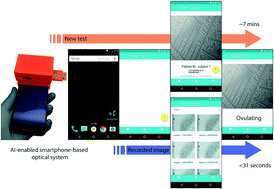Researchers develop smartphone-based ovulation test

Investigators from Brigham and Women's Hospital are developing an automated, low-cost tool to predict a woman's ovulation and aid in family planning. Capitalizing on advancements in several areas, including microfluidics, artificial intelligence (AI) and the ubiquity of smartphones, the team has built an ovulation testing tool that can automatically detect fern patterns—a marker of ovulation—in a saliva sample. The team evaluated the performance of the device using artificial saliva in the lab and validated results in human saliva samples from six subjects, observing greater than 99 percent accuracy in effectively predicting ovulation. The team's results are published in Lab on a Chip.
"Before we started this project, we weren't aware that such a need existed. When we published last year on a technology for analyzing sperm to detect male infertility, we were approached by those who had read about our work and were wondering if we could develop a smart-phone based system to provide ovulation testing at home," said corresponding author Hadi Shafiee, Ph.D., principal investigator at the BWH Division of Engineering in Medicine and Renal Division of Medicine. "Our study indicates that an accurate, automated and low-cost test is indeed possible."
Current methods for monitoring woman's fertility are often costly or subjective. These methods include ovulation detection through luteinizing hormone (LH) level determination (a clinical blood test or at-home urine "dip stick" test), rectal or basal body temperature analysis, cervical mucus characterization and salivary ferning analysis. Salivary ferning refers to the unique appearance of dried saliva from a woman who is ovulating—when collected on a glass slide, saliva takes on a crystallized structure that resembles fern leaves. While relatively inexpensive and simple, salivary fern analysis is highly subjective; when performed by the lay consumer, this approach is prone to misinterpretation.
To overcome this challenge, Shafiee and colleagues developed an automated process for detecting ferning in a saliva sample. The developed AI algorithm was pre-trained with 1.4 million ImageNet images and retrained with more than 1500 salivary ferning images to be able to classify saliva images into two categories: Ovulating and non-ovulating samples.
The team then evaluated the system's ability to differentiate ovulating and non-ovulating human saliva samples from six subjects. The women collected and tested their saliva samples usingthe cellphone system during both ovulating and non-ovulating phases of their menstrual cycle (results were confirmed using a urine test). To perform the test, saliva was collected on a microfluidic device, smeared, and left to air dry. The microfluidic device with the air-dried sample was then inserted into a 3-D printed optical attachment affixed to a smartphone. The software then analyzed the fern patterns, correctly identifying ovulation in 99 percent of samples and non-ovulation in 100 percent of the samples.
"One of the biggest advantages to this method is cost—whereas the cost of non-reusable urine stick tests can add up to $210 to $240 over the course of six months, our device represents the possibility of a one-time purchase," said co-author Manoj Kumar Kanakasabapathy, a senior research assistant in the Shafiee laboratory. "Beyond human ovulation, there are applications here as well for animal breeding and even for dry eye disease, which can also produce fern-like patterns in samples from eye mucosa."
"One of the biggest problems with saliva-based tests, we realized, was that users find it difficult to interpret the fern patterns," said Prudhvi Thirumalaraju, another co-author of this study and a senior research assistant in Shafiee's laboratory. "We figured that advances in AI can be put to good use here, to help people get objective results on their smartphones."
The new system is constrained by some of the same limitations as traditional ovulation tests, and cannot detect ovulation in women with estrogen imbalance, cysts in the ovaries, and those who take fertility medications. Smoking or alcohol consumption may also interfere with accurate detection. The device will require additional testing in a larger population and approval by the Federal Drug Administration before it can be brought to market.
More information: Vaishnavi Potluri et al, An inexpensive smartphone-based device for point-of-care ovulation testing, Lab on a Chip (2018). DOI: 10.1039/C8LC00792F
Journal information: Lab on a Chip
Provided by Brigham and Women's Hospital


















